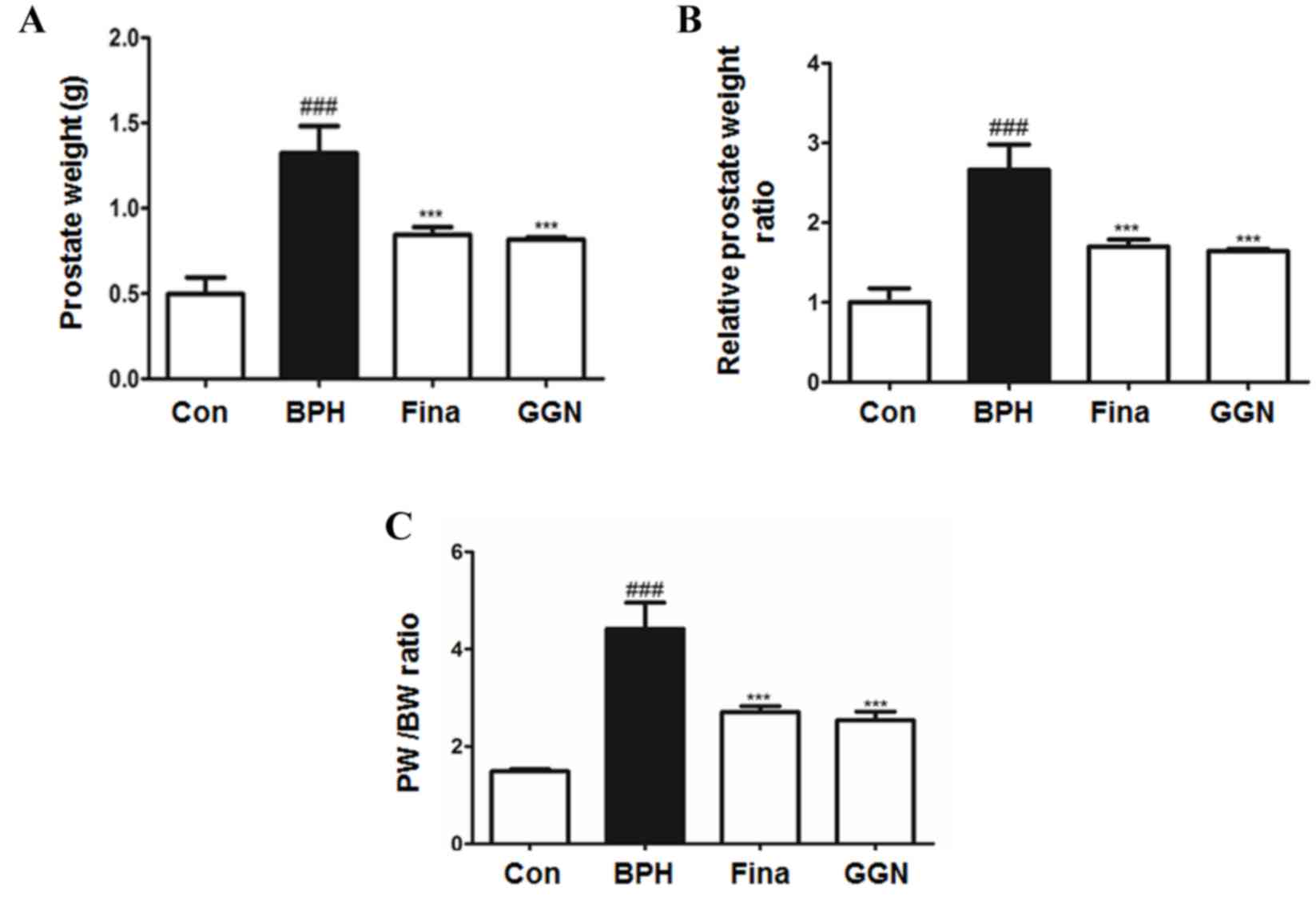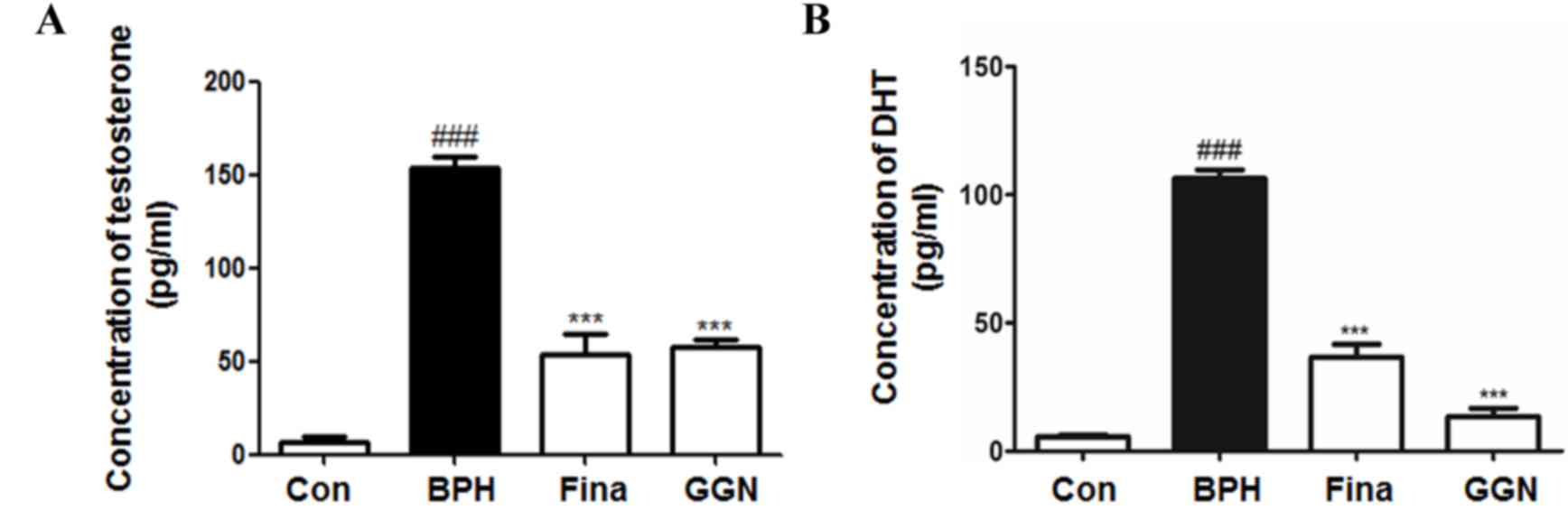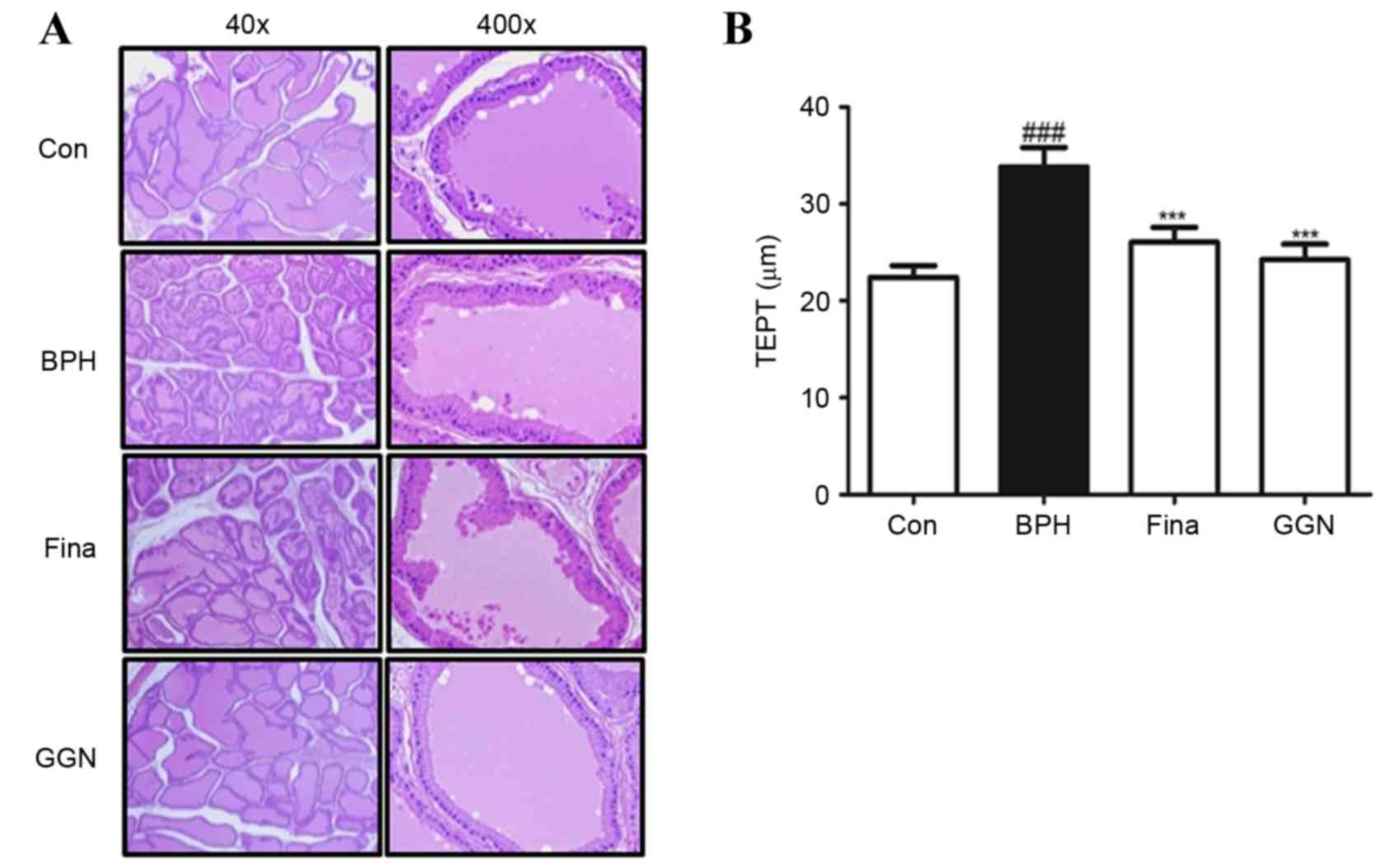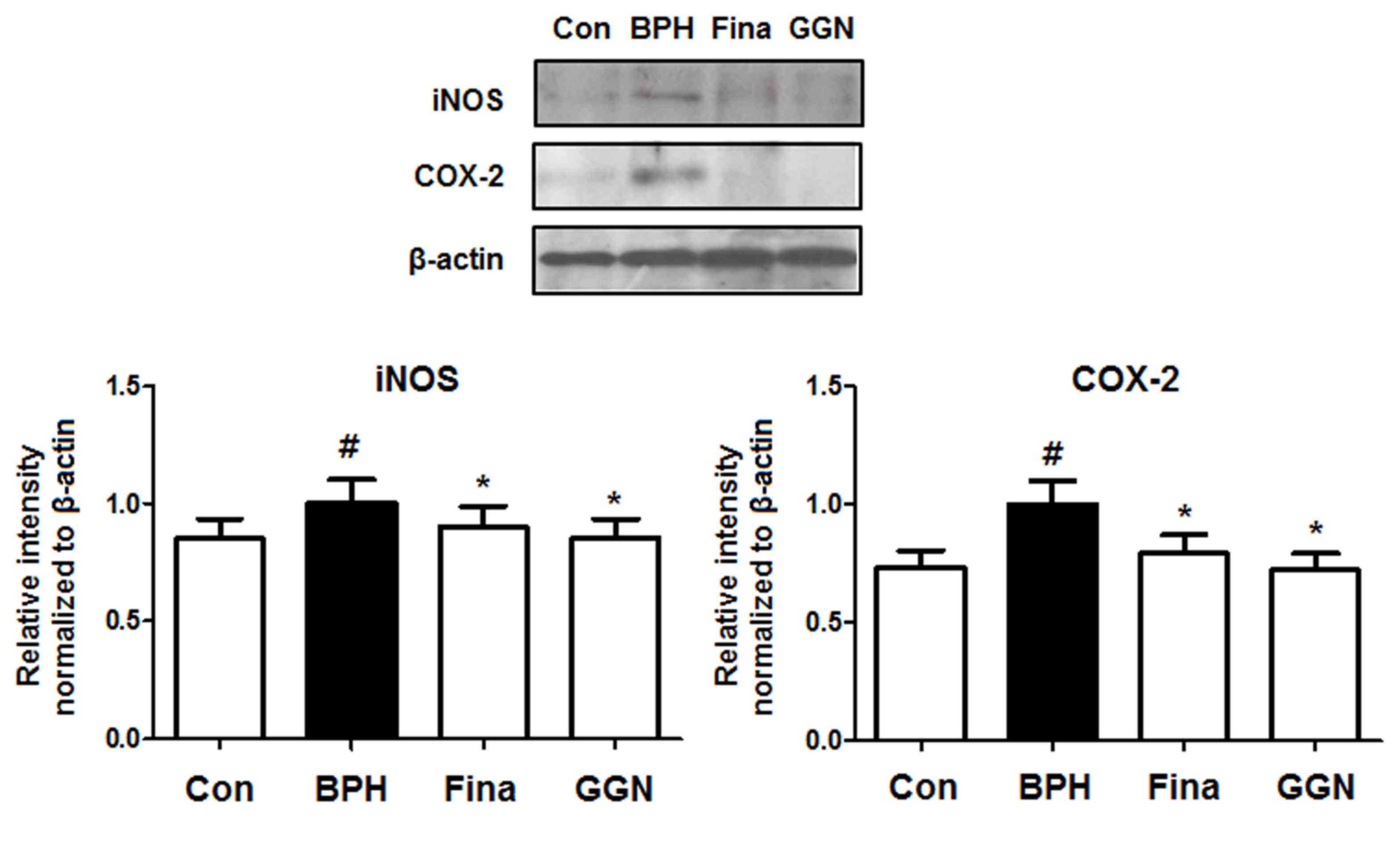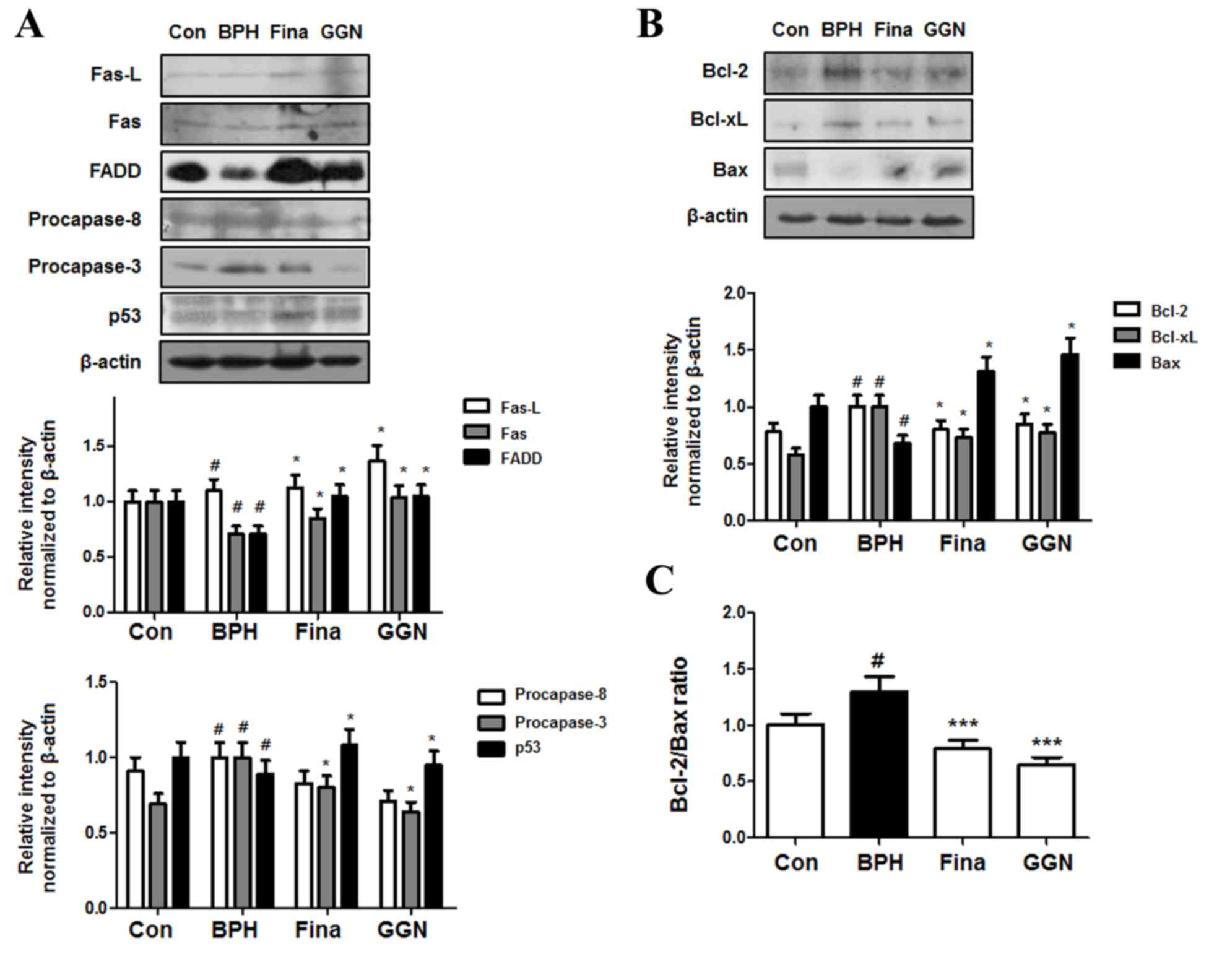The traditional Korean herbal medicine Ga-Gam-Nai-Go-Hyan suppresses testosterone-induced benign prostatic hyperplasia by regulating inflammatory responses and apoptosis
- Authors:
- Published online on: January 25, 2017 https://doi.org/10.3892/etm.2017.4088
- Pages: 1025-1031
Abstract
Introduction
Benign prostatic hyperplasia (BPH) is one of the most common chronic diseases in men (1). A previous epidemiological study has determined that >50% of men over the age of 50 years exhibit symptoms of BPH, such as urinary urgency and retention, and the incidence rate gradually increases with age (2). Aging and androgens are known to be the two main factors associated with the development of BPH, and it has previously been reported that inflammation may be another key factor in prostatic enlargement (3,4). In addition, repeated tissue damage due to chronic inflammation may provoke compensatory cellular proliferation, which increases the risk of hyperplastic growth (3,5). Chronic inflammation is able to induce proliferation in prostate tissue by affecting apoptotic protein expression. Cyclooxygenase (COX)-2 inhibition is able to significantly increase apoptotic activity in prostate cells via directly upregulating B-cell lymphoma (Bcl)-2 expression (6). Cell growth in the normal prostate is regulated via a delicate balance of cell death and proliferation; therefore, disruption of the molecular mechanisms that regulate these processes may lead to a state of epithelial and stromal hyperplasia (7,8).
At present, therapy for BPH is largely based on the use of α1-andrenergic receptor blockers and 5α-reductase inhibitors, which relax prostatic smooth muscle and reduce prostatic volume, respectively (9,10). Data from a previous systematic review indicates improved urine flow, nocturia and quality of life resulting from these treatments when used in combination or as monotherapies (11). Recently, the use of phosphodiesterase type 5 (PDE5) inhibitors was also recognized as an effective treatment for BPH (12). These pharmacological agents are effective; however, they induce undesirable adverse effects, including blood loss, urinary incontinence, infection, sexual dysfunction and morphological changes in the prostate (13,14). Therefore, it is necessary to identify novel effective herbal products for the treatment of BPH that are also safe for long-term use.
Ga-Gam-Nai-Go-Hyan (GGN) is an oriental herbal blend that has been used for a long time in Korea (15). It is composed of nine herbs: Morinda officinalis Haw, Cistanche salsa, Cornus officinalis, Cuscuta japonica Chois, Psoralea corylifolia L, Dendrobium nobile Lindley, Trigonella foenumgraecum L, Foeniculum vulgare Mill and Aconitum carmichaeli Debeaux (Table I). It has previously been reported that GGN is effective in the treatment of pallor, dizziness, chronic prostatitis, impotence and BPH (15). In addition, GGN has been used to treat patients with genital herpes, which may support its use in the treatment of GGN, as Trichomonas vaginalis has been detected in the urine of patients with BPH, which may indicate an association between infections of the genital system and BPH (16). A Korean medicine book entitled The Treasured Mirror of Eastern Medicine reported that the primary therapeutic facets of herbs used in GGN are similar to those of therapeutic agents used in the treatment of BPH (17). Certain major active components of GGN, including quercetin, kaempferol, coumarins and lignin glycosides, have been previously reported to exhibit anti-inflammatory and anti-oxidative qualities (18–21). Furthermore, a recent study by our group revealed that Cistanche salsa extract elicits an anti-proliferative effect on the prostate tissue of rats with BPH (22). Although studies on the physiological functions of the major active components of GGN have been performed, the molecular mechanism(s) underlying the effect of GGN on BPH have not yet been investigated; therefore, the aim of the present study was to assess the anti-proliferative effects of GGN in a testosterone-induced rat model of BPH, and to demonstrate that it functions through regulation of the inflammatory response and apoptotic protein expression.
Materials and methods
Materials and reagents
All herbs used to prepare GGN were purchased from Omniherb (Dong Woo Dang Pharmacy Co. Ltd., Yeongcheon, Korea). Finasteride was obtained from Merck & Co., Inc. (Whitehouse Station, NJ, USA). Antibodies against inducible nitric oxide synthase (iNOS; M-19; sc-650), COX-2 (C-20; sc-1745), procaspase-3 (E-8; sc-7272), procaspase-8 (C-20; sc-6136), B-cell lymphoma-2 (Bcl-2; C-2; sc-7382), Bcl-extra large (Bcl-xL; H-5; sc-8392), Bcl-2-associated X protein (Bax; B-9; sc-7480), p53 (FL-393; sc-6243), Fas (A-20; sc-1023), Fas ligand (Fas-L; C-178; sc-6237) and β-actin (ACTBD11B7; sc-81178) were purchased from Santa Cruz Biotechnology, Inc. (Dallas, TX, USA). An antibody against Fas-associated protein with death domain (FADD; ab24533) was purchased from Abcam (Cambridge, UK). The horeseadish peroxidase-conjugated secondary antibodies (goat anti-rabbit, 111-035-003; rabbit anti-mouse, 315-035-003; and donkey anti-goat, 705-035-003) were purchased from Jackson ImmunoResearch Laboratories, Inc. (West Grove, PA, USA). All other reagents were purchased from Sigma-Aldrich (Merck Millipore, Darmstadt, Germany).
Preparation of GGN
GGN consists of nine different herbs; Morinda officinalis How (120 g), Cistanche deserticola Y. C. Ma. (120 g), Cornus officinalis Sieb. et. Zucc. (120 g), Cuscuta chinensis Lamark (120 g), Psoralea corylifolia L. (100 g), Dendrobium nobile Lindl. (80 g), Trigonella foenum-graecum L. (80 g), Foeniculum vulgare Mill. (40 g) and Aconitum carmichaeli Debx. (20 g). The herbs had a moisture content of <13% by weight and were air-dried. The combination of herbs was extracted with 50% (v/v) ethanol-water at 60°C for 8 h. The extracts were then filtered through 15-µm cartridge paper and ethanol was removed via vacuum rotary evaporation (Eyela; Tokyo Rikakikai Co., Ltd., Tokyo Japan). The concentrates were freeze-dried and the yield was 12%. Powders were dissolved in distilled water prior to experiments and residual powders were stored at −20°C.
Animals
Ten-week-old male Wistar rats (n=24; weight, 200±20 g) were purchased from Daehan Biolink Co., Ltd., (Republic of Korea). Rats were housed under constant conditions (temperature, 22±2°C; humidity, 55±9%; 12 h light/dark cycle; ad libitum access to food and water) in accordance with the Guide for the Care and Use of Laboratory Animals. All procedures were approved by the Ethics Committee for Animal Care and the Use of Laboratory Animals at Sang-ji University (Wonju, Korea; approval documents, 2013-03;) and conducted in accordance with University guidelines. Rats were randomly distributed into four groups (n=6 in each); the sham-operated group (Con; administered with 200 µl distilled water orally), the BPH model group (BPH), the BPH-induced group administrated with finasteride (Fina; 5 mg/kg/day; p.o. Merck & Co., Inc.) and the BPH-induced group administrated with GGN (GGN; 100 mg/kg/day; p.o.). BPH was induced in rats via castration and subsequent subcutaneous injections of 100 µl testosterone propionate (Waco Pure Chemical Industries, Ltd., Osaka, Japan; 10 mg/kg/day), as previously reported (23). At the end of the four-week period, body weight was recorded and rats were fasted for 12 h. The following day, all rats were sacrificed by cervical dislocation following anesthetization with Zoletil 50 (20 mg/kg intraperitoneally; Virbac, Carros, France), and blood samples were obtained via cardiac puncture. Prostatic tissue was excised, rinsed, weighed and stored at −70°C until use.
Prostate weight to body weight ratio
Prostatic tissues were harvested, rinsed, and weighed immediately following sacrifice. The prostate weight to body weight (PW/BW) ratio was calculated. The relative prostate weight ratio was calculated as follows: Relative prostate weight ratio=prostate weight of rats in the experimental groups (BPH, Fina, GGN)/prostate weight of rats in the Con group.
Serum analysis
Serum concentrations of testosterone were determined using a testosterone enzyme immunoassay kit (582701; Cayman Chemical Co., Ann Arbor, MI, USA). Serum concentrations of dihydrotestosterone (DHT) were determined via enzymatic methods using a commercially available assay kit (11-DHTHU-E01; ALPCO, Salem, NH, USA) according to the manufacturer's protocol.
Histological analysis
The prostatic tissue was fixed in 4% buffered formalin and embedded in paraffin, and 4-µm thick sections were cut. The sections were stained with hematoxylin and eosin for histological examination, and images were acquired using an SZX10 microscope (Olympus Corp., Tokyo, Japan). The thickness of the epithelium in the prostate tissue (TETP) was measured using the Leica Application Suite software (LAS ver. 3.3.0; Leica Microsystems, Inc., Buffalo Grove, IL, USA).
Western blot analysis
The prostatic tissue from each rat was homogenized in PRO-PREP lysis buffer (Intron Biotechnology Inc., Seongnam, Korea). Tissue extracts were centrifuged at 16,000 × g (4°C) for 20 min, and the resulting supernatant was transferred to a clean tube. The protein concentration was determined using a Bio-Rad protein assay (Bio-Rad Laboratories, Inc., Hercules, CA, USA) according to the manufacturer's protocol. Aliquots of each protein sample (30 µg) were separated by 10–12% SDS-PAGE and transferred onto a polyvinylidene fluoride membrane (Immobilion-P transfer membrane; Merck Millipore). The membranes were blocked with 2.5% skimmed milk at 4°C for 30 min and incubated overnight with 1:1,000 dilutions of the primary antibodies (anti-iNOS, anti-COX-2, anti-caspase-3, anti-caspase-8, anti-Bcl-xL, anti-Bax, anti-P-53, anti-Fas, anti-Fas-L, anti-FADD and anti-β-actin). The blots were washed three times with Tween-20/TBS and then incubated with 1:2,000 dillutions of corresponding secondary antibodies (Santa Cruz Biotechnology, Inc.) for 2 h at room temperature. Blots were again washed three times with Tween-20/TBS and the immunoreactive protein bands were visualized via enhanced chemiluminescence, and the developed blots were exposed to X-ray film (GE Healthcare Bio-Sciences, Pittsburgh, PA, USA). Each blot was performed in triplicate and densitometric analysis was performed using Bio-rad Quantity One Software (version 4.6.3; Bio-Rad Laboratories, Inc.).
Statistical analysis
Values are expressed as the mean ± standard error of the mean for six rats. Data were analyzed using one-way analysis of variance with Dunnett's test and P<0.05 was considered to indicate a statistically significant difference. Statistical analysis was performed using SPSS statistical analysis software (version 19.0; International Business Machines, Armonk, NY, USA).
Results
GGN decreases prostate weight in a rat model of BPH
The mean prostate weight of rats in the BPH group was significantly higher than that of rats in all other groups (P<0.001). Compared with BPH rats, the prostate weight of rats in the Fina and GGN groups were significantly decreased (P<0.001; Fig. 1A). The relative prostate weight ratio in the BPH group was 2.66 times that in the Con group, which was a significant increase (P<0.001), whereas in the GGN group, prostate weight was only 1.64 times that in the Con group (Fig. 1B). In addition, the PW/BW ratio in the BPH group was also significantly higher than that in the other groups (P<0.001). Compared with the BPH group, the PW/BW ratio was significantly lower in the Fina and GGN groups (P<0.001), whereas no significant difference was observed between the PW/BW ratios of the GGN group (2.54) and the Fina group (2.71).
GGN decreases serum testosterone and DHT levels in a rat model of BPH
The serum testosterone and DHT levels of the rats in each group are displayed in Fig. 2. The concentrations of the testosterone and DHT in the BPH group were significantly higher than those in all other groups (P<0.001). In the Fina and GGN groups, serum testosterone and DHT levels were significantly lower than those in the BHP group (P<0.001). Of note, DHT levels in the GGN group were markedly lower than those in the Fina group.
GGN attenuates testosterone-induced morphological changes of the prostate gland
The effect of GGN on prostate gland morphology was investigated by histological analysis (Fig. 3). Rats in the BPH group exhibited histological changes typical of prostatic hyperplasia: Thickened glandular epithelium, vacuolated cytoplasm pointing into the glandular lumen and a decreased glandular luminal area (Fig. 3A). Administration of GGN for four weeks suppressed these typical histological patterns. The TETP was significantly higher in the BPH-induced group than in the other groups (P<0.001; Fig. 3B). In brief, histologic examination revealed that administration of finasteride or GGN ameliorated the major features of prostatic hyperplasia observed in the BPH group, although certain minor features of prostatic hyperplasia remained.
GGN decreases inflammatory proteins in prostatic tissue of rats with BPH
Inflammation is associated with the increased proliferation of prostatic epithelial cells (24). In patients with BPH, iNOS, which provides a sustained release of reactive nitrogen species that may induce cell damage, is typically present (25). In addition, COX-2, which generates pro-inflammatory prostaglandins, is detected in inflammatory cells (4). In the present study, the levels of iNOS and COX-2 in the prostatic tissue of BPH-induced rats were analyzed by western blotting to investigate the effects of GGN on inflammation. Compared with the Con group, treatment with testosterone increased the levels of iNOS and COX-2 in the BPH-induced group. By contrast, the Fina and GGN groups showed markedly reduced levels of these inflammatory proteins compared with the BPH group (Fig. 4).
GGN enhances apoptotic signaling in prostatic tissue of rats with BPH
BPH arises from an imbalance between cell proliferation and apoptosis (3). The two main apoptotic pathways are the intrinsic and extrinsic pathways. In the extrinsic pathway, apoptosis is induced by death activators binding to receptors at the cell surface and accumulation of the adaptor molecule FADD, which leads to the activation of initiator caspase (26). In the present study, the expression levels of proteins in the extrinsic pathway were assessed (Fig. 5A), and the Fina and GGN-treated group exhibited higher protein levels of Fas-L, Fas, FADD and p53, and lower protein levels of procaspase-8 and procaspase-3 compared with the levels in the BPH group.
In the intrinsic pathway, apoptosis, including disruption of the mitochondrial membrane potential, is critically regulated by Bcl-2 family proteins (27). As demonstrated in Fig. 5B, the Fina and GGN group exhibited lower levels of the anti-apoptotic proteins Bcl-2 and Bcl-xL, and higher levels of the pro-apoptotic protein Bax than the BPH group. Therefore, although the ratio of Bcl-2 to Bax was significantly increased in the BPH group compared with the control group (P<0.05), the ratio decreased significantly following treatment with Fina and GGN (P<0.001), suggesting that GGN-induced apoptosis is regulated by the Bcl-2 family of proteins, which are important mediators of apoptosis (Fig. 5C).
Discussion
BPH is the most prevalent urologic health concern in the male population, with a histological prevalence at autopsy of 50% in men aged 50–60 years and 90% in men aged >80 years (28). It is characterized by the non-malignant overgrowth of prostatic tissue surrounding the urethra, and is usually present with one or more co-morbidities, including bladder dysfunction and hypertrophy, which may lead to acute urinary retention (2). Previously, androgens and age have been considered as the main determinants of prostate enlargement; however, the potentially important role of chronic inflammation in the pathogenesis of BPH has recently been identified (29).
Hormonal imbalance has an important role in the pathogenesis of BPH via induction of inflammatory responses and reduction of apoptosis, and testosterone has been shown to be associated with BPH (4). In the present study, rats were administered testosterone for four weeks to induce BPH. Prostate weight ratios and DHT levels in the BPH group were higher than those in the Con group, indicating that testosterone administration successfully induced BPH. However, four weeks of GGN treatment effectively inhibited BPH, and these effects were comparable to those observed in the Fina group.
In the inflammatory cells of the prostate, iNOS is the factor that predominantly activates reactive nitrogen, which is able to damage cells (30). Hyperplastic prostate tissue is characterized by increased NOS expression in the epithelial cells compared with normal tissue (31). In addition, nitric oxide may also be converted by COX enzymes to proinflammatory prostaglandins (32), and COX-2 has been detected in the epithelium and interstitial spaces of inflammatory cells (30). In the present study, the protein expression levels of COX-2 and iNOS were analyzed in a rat model of BPH using western blotting. The levels of COX-2 and iNOS proteins in the BPH group were higher than those in the Con group. By contrast, COX-2 and iNOS levels in the GGN group were lower than those in the BPH group. These results indicated that GGN may suppress the growth of prostatic cells through its anti-inflammatory effects.
In mammalian cells, apoptosis proceeds via the extrinsic and intrinsic pathways. The extrinsic pathway is triggered by the binding of extracellular signaling factors to death receptors at the plasma membrane. Fas is a cell-surface receptor protein belonging to the tumor necrosis factor receptor superfamily, and its physiological ligand, Fas-L, is a member of the corresponding tumor necrosis factor cytokine family (33). Fas-L-Fas signaling triggers apoptosis through FADD, and activation of the aspartate-specific cysteine protease, caspase-8, initiating a cascade of caspase activation leading to phagocytosis of the cell (34). The intrinsic pathway is activated by intracellular damage, such as oxidative stress, and is controlled by the mitochondria, which are regulated by the Bcl-2 protein family. Bcl-2 proteins are categorized based on their structure and function; this family includes anti-apoptotic proteins, such as Bcl-2 and Bcl-xL, and proapoptotic proteins, such as Bax (27). In various systems, the Bcl-2 family modulates apoptosis, with the Bcl-2/Bax ratio serving as a rheostat to determine a cell's susceptibility to apoptosis (35). p53 induces the release of various proapoptotic factors from the intermembrane space of the mitochondria (36). p53 interacts with Bax by binding to its Bcl-2 homolog 3 domains, leading to cytochrome C release by mitochondria into the cytoplasm (37). Cytochrome C activates caspase-9, which in turn activates a series of caspases, including caspase-3 (38). In the present study, it was demonstrated that administration of GGN increased the levels of Fas, Fas-L, FADD and p53, and decreased the levels of procaspase-3 and procaspase-8. In addition, GGN reduced the levels of Bcl-2 and Bcl-xL and increased the levels of Bax protein. These results indicated that GGN-induced apoptosis in a rat model of BPH is most likely due to stimulation of death receptors and the mitochondrial pathway.
In conclusion, the findings of the present study suggested that GGN is able to prevent BPH by regulating inflammatory responses and apoptosis. Based on this hypothesis, GGN may have applications as a therapeutic agent for the treatment of patients with BPH.
Acknowledgements
The present study was supported by a grant from the Korea Health Technology R&D Project through the Korea Health Industry Development Institute (KHIDI), funded by the Ministry of Health & Welfare, Republic of Korea (grant no. HI16C0477).
References
|
Boyle P, Maisonneuve P and Napalkov P: Incidence of prostate cancer will double by the year 2030: The argument for. Eur Urol. 29:(Suppl 2). S3–S9. 1996. | |
|
McVary KT: BPH: Epidemiology and comorbidities. Am J Manag Care. 12:(Suppl 5). S122–S128. 2006.PubMed/NCBI | |
|
Sciarra A, Di Silverio F, Salciccia S, Gomez AM Autran, Gentilucci A and Gentile V: Inflammation and chronic prostatic diseases: Evidence for a link? Eur Urol. 52:964–972. 2007. View Article : Google Scholar : PubMed/NCBI | |
|
Sciarra A, Mariotti G, Salciccia S, Gomez A Autran, Monti S, Toscano V and Di Silverio F: Prostate growth and inflammation. J Steroid Biochem Mol Biol. 108:254–260. 2008. View Article : Google Scholar : PubMed/NCBI | |
|
Robert G, Descazeaud A, Nicolaïew N, Terry S, Sirab N, Vacherot F, Maillé P, Allory Y and de la Taille A: Inflammation in benign prostatic hyperplasia: A 282 patients' immunohistochemical analysis. Prostate. 69:1774–1780. 2009. View Article : Google Scholar : PubMed/NCBI | |
|
Di Silverio F, Bosman C, Salvatori M, Albanesi L, Pannunzi L Proietti, Ciccariello M, Cardi A, Salvatori G and Sciarra A: Combination therapy with rofecoxib and finasteride in the treatment of men with lower urinary tract symptoms (LUTS) and benign prostatic hyperplasia (BPH). Eur Urol. 47:72–78; discussion 78–79. 2005. View Article : Google Scholar : PubMed/NCBI | |
|
Nicholson TM and Ricke WA: Androgens and estrogens in benign prostatic hyperplasia: Past, present and future. Differentiation. 82:184–199. 2011. View Article : Google Scholar : PubMed/NCBI | |
|
Kyprianou N, Tu H and Jacobs SC: Apoptotic versus proliferative activities in human benign prostatic hyperplasia. Hum Pathol. 27:668–675. 1996. View Article : Google Scholar : PubMed/NCBI | |
|
Rittmaster RS: 5alpha-reductase inhibitors in benign prostatic hyperplasia and prostate cancer risk reduction. Best Pract Res Clin Endocrinol Metab. 22:389–402. 2008. View Article : Google Scholar : PubMed/NCBI | |
|
Bartsch G, Rittmaster RS and Klocker H: Dihydrotestosterone and the concept of 5alpha-reductase inhibition in human benign prostatic hyperplasia. Eur Urol. 37:367–380. 2000. View Article : Google Scholar : PubMed/NCBI | |
|
Tacklind J, Fink HA, Macdonald R, Rutks I and Wilt TJ: Finasteride for benign prostatic hyperplasia. Cochrane Database Syst Rev. CD0060152010.PubMed/NCBI | |
|
Oelke M, Bachmann A, Descazeaud A, Emberton M, Gravas S, Michel MC, N'dow J, Nordling J and de la Rosette JJ: European Association of Urology: EAU guidelines on the treatment and follow-up of non-neurogenic male lower urinary tract symptoms including benign prostatic obstruction. Eur Urol. 64:118–140. 2013. View Article : Google Scholar : PubMed/NCBI | |
|
Kyprianou N: Doxazosin and terazosin suppress prostate growth by inducing apoptosis: Clinical significance. J Urol. 169:1520–1525. 2003. View Article : Google Scholar : PubMed/NCBI | |
|
Morelli A, Filippi S, Comeglio P, Sarchielli E, Chavalmane AK, Vignozzi L, Fibbi B, Silvestrini E, Sandner P, Gacci M, et al: Acute vardenafil administration improves bladder oxygenation in spontaneously hypertensive rats. J Sex Med. 7:107–120. 2010. View Article : Google Scholar : PubMed/NCBI | |
|
Kim JKSB, Lee EJ and Kim HK: Study on the treatment of benign prostatic hyperplasia (BPH) in oriental medicine. The Journal of Korean Oriental Medical Society. 19:211–227. 1998. | |
|
Kim JH, Kim SS, Han IH, Sim S, Ahn MH and Ryu JS: Proliferation of prostate stromal cell induced by benign prostatic hyperplasia epithelial cell stimulated with Trichomonas vaginalis via crosstalk with mast cell. Prostate. 76:1431–1444. 2016. View Article : Google Scholar : PubMed/NCBI | |
|
Heo J: The Treasured Mirror of Eastern Medicine. 2. 3rd. Yoekang Press; Seoul: 2005 | |
|
Zou W, Liu W, Yang B, Wu L, Yang J, Zou T, Liu F, Xia L and Zhang D: Quercetin protects against perfluorooctanoic acid-induced liver injury by attenuating oxidative stress and inflammatory response in mice. Int Immunopharmacol. 28:129–135. 2015. View Article : Google Scholar : PubMed/NCBI | |
|
Devi KP, Malar DS, Nabavi SF, Sureda A, Xiao J, Nabavi SM and Daglia M: Kaempferol and inflammation: From chemistry to medicine. Pharmacol Res. 99:1–10. 2015. View Article : Google Scholar : PubMed/NCBI | |
|
Zeng KW, Yu Q, Liao LX, Song FJ, Lv HN, Jiang Y and Tu PF: Anti-neuroinflammatory effect of MC13, a novel coumarin compound from Condiment Murraya, through inhibiting lipopolysaccharide-induced TRAF6-TAK1-NF-kB, P38/ERK MAPKS and Jak2-Stat1/Stat3 pathways. J Cell Biochem. 116:1286–1299. 2015. View Article : Google Scholar : PubMed/NCBI | |
|
Lee HS, Kang P, Kim KY and Seol GH: Foeniculum vulgare Mill. Protects against lipopolysaccharide-induced acute lung injury in mice through ERK-dependent NF-kappaB activation. Korean J Physiol Pharmacol. 19:183–189. 2015. View Article : Google Scholar : PubMed/NCBI | |
|
Jeon EJ, Chung KS and An HJ: Anti-proliferation effects of Cistanches salsa on the progression of benign prostatic hyperplasia. Can J Physiol Pharmacol. 94:104–111. 2016. View Article : Google Scholar : PubMed/NCBI | |
|
Guo QL, Ding QL and Wu ZQ: Effect of baicalein on experimental prostatic hyperplasia in rats and mice. Biol Pharm Bull. 27:333–337. 2004. View Article : Google Scholar : PubMed/NCBI | |
|
De Nunzio C, Kramer G, Marberger M, Montironi R, Nelson W, Schröder F, Sciarra A and Tubaro A: The controversial relationship between benign prostatic hyperplasia and prostate cancer: The role of inflammation. Eur Urol. 60:106–117. 2011. View Article : Google Scholar : PubMed/NCBI | |
|
Baltaci S, Orhan D, Gögüs C, Türkölmez K, Tulunay O and Gögüs O: Inducible nitric oxide synthase expression in benign prostatic hyperplasia, low- and high-grade prostatic intraepithelial neoplasia and prostatic carcinoma. BJU Int. 88:100–103. 2001. View Article : Google Scholar : PubMed/NCBI | |
|
Chiu TH, Lan KY, Yang MD, Lin JJ, Hsia TC, Wu CT, Yang JS, Chueh FS and Chung JG: Diallyl sulfide promotes cell-cycle arrest through the p53 expression and triggers induction of apoptosis via caspase- and mitochondria-dependent signaling pathways in human cervical cancer Ca Ski cells. Nutr Cancer. 65:505–514. 2013. View Article : Google Scholar : PubMed/NCBI | |
|
Petros AM, Olejniczak ET and Fesik SW: Structural biology of the Bcl-2 family of proteins. Biochim Biophys Acta. 1644:83–94. 2004. View Article : Google Scholar : PubMed/NCBI | |
|
Elkahwaji JE: The role of inflammatory mediators in the development of prostatic hyperplasia and prostate cancer. Res Rep Urol. 5:1–10. 2012.PubMed/NCBI | |
|
Fibbi B, Penna G, Morelli A, Adorini L and Maggi M: Chronic inflammation in the pathogenesis of benign prostatic hyperplasia. Int J Androl. 33:475–488. 2010. View Article : Google Scholar : PubMed/NCBI | |
|
Chughtai B, Lee R, Te A and Kaplan S: Role of inflammation in benign prostatic hyperplasia. Rev Urol. 13:147–150. 2011.PubMed/NCBI | |
|
Wang W, Bergh A and Damber JE: Chronic inflammation in benign prostate hyperplasia is associated with focal upregulation of cyclooxygenase-2, Bcl-2, and cell proliferation in the glandular epithelium. Prostate. 61:60–72. 2004. View Article : Google Scholar : PubMed/NCBI | |
|
Sugar LM: Inflammation and prostate cancer. Can J Urol. 13:(Suppl 1). 46–47. 2006.PubMed/NCBI | |
|
Strasser A, Jost PJ and Nagata S: The many roles of FAS receptor signaling in the immune system. Immunity. 30:180–192. 2009. View Article : Google Scholar : PubMed/NCBI | |
|
Boatright KM, Renatus M, Scott FL, Sperandio S, Shin H, Pedersen IM, Ricci JE, Edris WA, Sutherlin DP, Green DR and Salvesen GS: A unified model for apical caspase activation. Mol Cell. 11:529–541. 2003. View Article : Google Scholar : PubMed/NCBI | |
|
Salakou S, Kardamakis D, Tsamandas AC, Zolota V, Apostolakis E, Tzelepi V, Papathanasopoulos P, Bonikos DS, Papapetropoulos T, Petsas T and Dougenis D: Increased Bax/Bcl-2 ratio up-regulates caspase-3 and increases apoptosis in the thymus of patients with myasthenia gravis. In Vivo. 21:123–132. 2007.PubMed/NCBI | |
|
Sun Y, Holley AK and St Clair DK: p53 regulation of energy metabolism and mitochondria regulation of p53 in cancer cells: An insight into the role of manganese superoxide dismutase. Curr Pharm Biotechnol. 14:261–273. 2013. View Article : Google Scholar : PubMed/NCBI | |
|
Galluzzi L, Morselli E, Kepp O, Tajeddine N and Kroemer G: Targeting p53 to mitochondria for cancer therapy. Cell Cycle. 7:1949–1955. 2008. View Article : Google Scholar : PubMed/NCBI | |
|
Teissier S, Ben Khalifa Y, Mori M, Pautier P, Desaintes C and Thierry F: A new E6/P63 pathway, together with a strong E7/E2F mitotic pathway, modulates the transcriptome in cervical cancer cells. J Virol. 81:9368–9376. 2007. View Article : Google Scholar : PubMed/NCBI |



